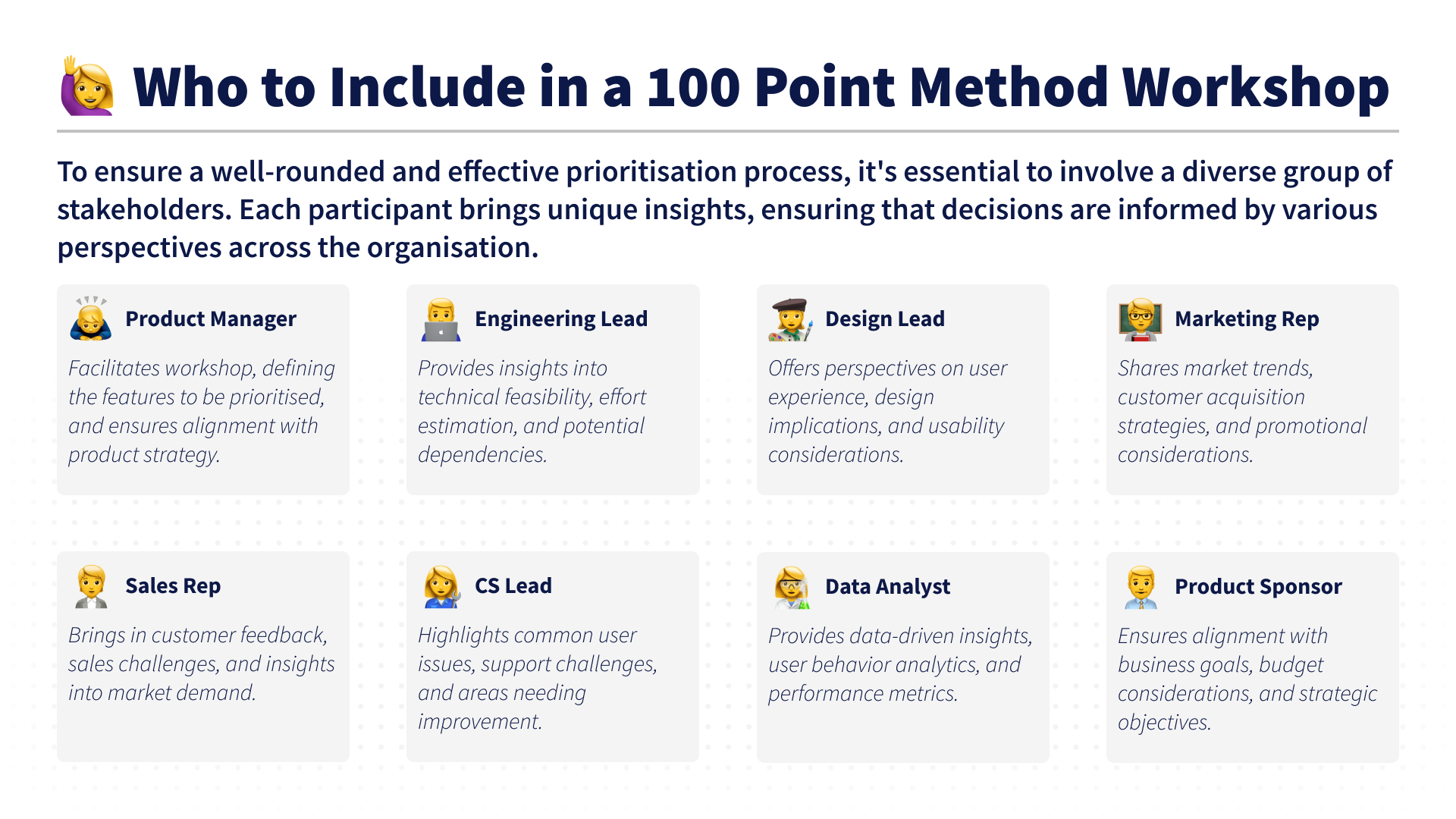


.png)
The 100 Point Method, also known as the "100-Dollar Test" or "Cumulative Voting," is a democratic prioritisation tool that simplifies decision-making in product management. By allocating points, it quantifies preferences, promotes stakeholder participation, and ensures strategic alignment, making complex decisions manageable.
📚 Methodology:
✅ Benefits:
❌ Limitations:
The 100 Point Method is a straightforward, yet effective, prioritisation tool widely used by Product Managers within group settings to make collective decisions where there are competing options or features and limited resources.
Also known as the “100-Dollar Test” or ‘Cumulative Voting”, this method offers a democratic and collaborative approach to decision-making. When resources are limited it can be difficult to decide which options should be prioritised within a product backlog. Add stakeholders with differing opinions on which option provides most value and it can become increasingly complex to decide the most appropriate way forward. Creating a dedicated workshop involving these stakeholders to discuss and form decisions is an essential step in maintaining relations and ensuring feature buy-in.
The beauty of the 100 point method lies in its simplicity and adaptability, transcending the complexities of traditional decision-making processes, allowing for a clear and quantifiable outcome to be made. This method not only encourages active participation from all stakeholders, but also provides a transparent view of collective preferences. Furthermore, it forces stakeholders to think critically about the importance of each option, considering factors like impact, feasibility, and alignment with strategic goals.
Through turning subjective opinions into objective data, the 100 Point Method makes decisions transparent and justifiable, ensuring the most valuable initiatives are recognised and pursued.
In the complex and fast-paced world of product management, making informed and strategic decisions about what to prioritise is crucial for success. The 100 Point Method emerges as a powerful tool in this context, especially when Product Managers face the challenge of deciding among a multitude of potential features, projects, or tasks, each with its own set of benefits and stakeholders. This prioritisation tool is particularly useful in scenarios where resources are limited, and the impact of decisions is significant—such as during the early stages of product development, when determining which features to build first, or when a team must decide how to allocate its time and budget effectively across competing product features or development priorities. By allowing stakeholders to distribute a fixed number of points across various options based on their perceived importance, the 100 Point Method facilitates a democratic and quantitative approach to decision-making. This introductory section aims not only to outline the steps involved in applying this method but also to provide a clear framework for when and why Product Managers should consider it an essential part of their toolkit.


1️⃣ Define the criteria
Start by clearly listing the options that require prioritisation. These might include features, project initiatives, or any decision points where a choice is necessary. Precision in defining each option ensures clarity throughout the process.
.png)
2️⃣ Identify stakeholders
Select a diverse group of stakeholders for participation. This group should include representatives from all relevant departments to ensure a holistic view of priorities across the organisation.

3️⃣ Allocate points
Give each participant an equal number of points (100 is recommended) to distribute. The method of allocation can vary, from digital platforms to physical tokens, depending on your setup.
4️⃣ Score the options
Participants assign their points among the options based on their perceived value or importance. This step is highly subjective and reflects the individual's or department's priorities and strategic vision.
5️⃣ Discuss allocations
After the allocation, facilitate a group discussion to explore the rationale behind the point distributions. This discussion is vital for uncovering insights and ensuring a shared understanding and alignment on priorities.
6️⃣ Calculate and prioritise
Sum up the points each option has received. Rank the options according to their total points to establish a clear priority order. This ranking will directly inform decision-making and resource allocation.
7️⃣ Make decisions
With the priorities now clear, make informed decisions on which options to execute, based on the collective input and strategic objectives. This final step translates the method's outcomes into actionable plans.
By meticulously following the methodology outlined above, Product Managers can confidently apply the 100 Point Method to their decision-making processes. This method not only ensures that all voices are heard but also quantifies the value and importance of various options in a democratic manner. As you integrate this tool into your prioritisation efforts, you will find it invaluable in navigating the complexities of product management, helping to clear the path toward strategic, informed, and consensus-driven decisions. Let the 100 Point Method empower you and your team to approach prioritisation with clarity and confidence, secure in the knowledge that you are making choices that are reflective of your collective priorities and strategic goals.
Now understanding how to effectively carry out a prioritisation workshop using the 100 Point Method, it is important to understand the benefits and limitations.

In conclusion, the 100 Point Method stands out as an invaluable tool for Product Managers navigating the intricate landscape of prioritisation within product development and management. Its simplicity, adaptability, and democratic nature make it especially useful in environments where resources are limited and consensus is key. By converting subjective opinions into objective data, it not only ensures a transparent and justifiable decision-making process but also fosters critical thinking and meaningful discussions among stakeholders. However, it's important to be mindful of its limitations, such as the potential for bias and the challenges of scalability. Despite these challenges, the 100 Point Method remains a powerful approach for achieving strategic alignment and ensuring that the most valuable initiatives receive the attention and resources they deserve. As Product Managers continue to seek effective ways to navigate complexities and drive their products forward, the 100 Point Method provides a clear and democratic path to prioritising with confidence and clarity.